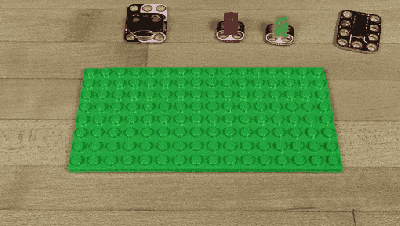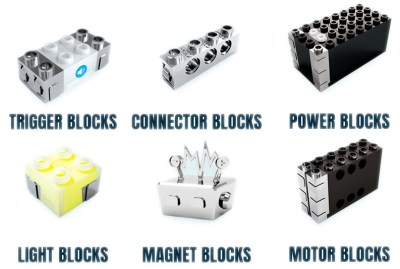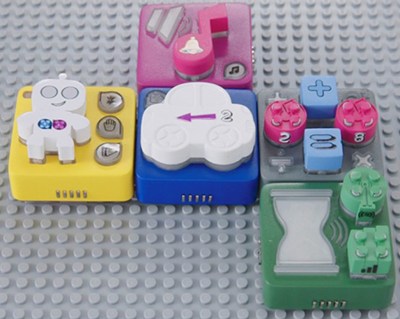Within the last few years, a lot of companies have started with the aim to disrupt the educational electronics industry using their LEGO-compatible sets. Now they’re ubiquitous, and fighting each other for their slice of space in your child’s box of bricks. What’s going on here?
Raison D’Être
The main reason for LEGO-compatibility is familiarity. Parents and children get LEGO. They have used it. They already have a bunch. When it comes to leveling up and learning about electronics, it makes sense to do that by adding on to a thing they already know and understand, and it means they can continue to play with and get more use from their existing sets. The parent choosing between something that’s LEGO-compatible and a completely separate ecosystem like littleBits (or Capsela) sees having to set aside all the LEGO and buy all new plastic parts and learn the new ecosystem, which is a significant re-investment. littleBits eventually caught on and started offering adapter plates, and that fact demonstrates how much demand there is to stick with the studs.
 LEGO already has the Mindstorms set, and they just released the Boost robot for helping teach coding, so one would think this a dangerous market in which to exist. Apple has a history of adding features to IOS that duplicate popular apps, wiping out the smaller companies, and with Mindstorms and Boost LEGO can do the same thing by adding to their product line. The LEGO-compatible electronics startups aren’t scared, though, because they believe LEGO’s price point is prohibitive for a lot of people, and the complexity of the kits is a further barrier to kids and educators.
LEGO already has the Mindstorms set, and they just released the Boost robot for helping teach coding, so one would think this a dangerous market in which to exist. Apple has a history of adding features to IOS that duplicate popular apps, wiping out the smaller companies, and with Mindstorms and Boost LEGO can do the same thing by adding to their product line. The LEGO-compatible electronics startups aren’t scared, though, because they believe LEGO’s price point is prohibitive for a lot of people, and the complexity of the kits is a further barrier to kids and educators.
These are valid points; LEGO does come with sticker shock, and working with Mindstorms involves programming. Still, these days it seems like people throw the letters S.T.E.M. on their products and expect parents and educators to throw gobs of money at them, so my jaded-business-guy guess is that claiming “LEGO-compatibility” serves as a price anchor and they only need to price themselves slightly below LEGO prices to make the argument for frugality. Toys are cheap, but electronics are not, and finding a gap for a company to exist is challenging. Also, LEGO has always been known for their easy-to-understand instructions. I’ve seen lots of elementary school kids at FIRST LEGO League competitions showing off their extensive knowledge of Mindstorms programming, which uses drag-and-drop blocks in a graphical user interface similar to Scratch.
For some of the LEGO-compatible companies, though, they perceive the barriers of Mindstorms as too high. Their goal is more about getting a light to blink, or a speaker to make noise, or a button to trigger an action, with no computers and no programming. Their aim is the Hello World of electronics.
This isn’t meant to sound like an advertisement for LEGO; it’s just an observation that LEGO is a big company with a premium market similar to Apple, and the little guys who are trying to play in the same sandbox are at risk of getting stomped by the big guy.
The Players
Each company has a different twist they claim makes them better than others. This is not an exhaustive list. There are new players popping in and out of existence all the time. The fear of obsolescence is one barrier that they have for sales; parents and teachers will have a hard time if the electronics sets they buy one year go out of business the next year and they can’t keep buying parts, so there is some justified reticence.
Crazy Circuits

Started by Brown Dog Gadgets, Crazy Circuits leaves the plastic parts to LEGO and makes circuit boards with giant holes that fit over the studs. Connectivity between elements is done with conductive tape or conductive thread. With lots of modules for lights, buttons, power, and even a TeensyLC, this is the closest to working with actual circuit boards, with lots of room to grow in complexity and in contributions from third parties building off their open source components. The lack of plastic allows for another possibility, too; the modules can be sewn into stuffed plushies or other non-LEGO projects.
We covered their giant solderless NES controller a few months ago.
E-Blox
Proud of their patent, E-Blox claims their differentiation is in the complete lack of wires. They have bricks coated with a metal alloy they’ve extensively tested to be safe and won’t wear, and still meets the tight tolerances of standard bricks and child toy safety requirements. Their current offering is almost entirely LEDs, though other features like motors and speakers are in the pipeline. They’ve only been around a year, and in that time have created an impressive number of injection molded tools for their parts. The company is founded by one of the same people behind Snap Circuits, so they have some history in this field.
Brixo
 Strangely enough, Brixo is also proud of their electricity-conducting blocks that don’t require wires. They’ve been around longer than E-Blox (their Kickstarter blew up in March 2016, but they only recently delivered) and have a more substantial library of parts, including inputs and outputs, and boast a Bluetooth connected module and app.
Strangely enough, Brixo is also proud of their electricity-conducting blocks that don’t require wires. They’ve been around longer than E-Blox (their Kickstarter blew up in March 2016, but they only recently delivered) and have a more substantial library of parts, including inputs and outputs, and boast a Bluetooth connected module and app.
littleBits
It’s a bit of a stretch to call littleBits LEGO-compatible, since it requires an adapter plate that they sell, but they didn’t start off with LEGO compatibility, and they’re making an effort. They have LOTS of modules, though, and lots of experience in the area of teaching kids electronics.
Brick Stuff
This isn’t really STEM (or STEAM, or STREAM, or any other acronym to try to induce parents to shove twenty dollar bills into the CD slot of their computer). Brick Stuff is all about making sets beautiful with tasteful mood lighting, and it’s easy to go down the rabbit hole with all the pictures of neat LEGO builds.
Algobrix

Algobrix is focused on the programming aspect, and they’ve made a variety of plastic parts that act like programming concepts (loops, inputs, outputs, parameters), with the goal of placing the blocks in certain ways to wirelessly control the Algobrix robot.
Cubroid
Also focused on programming, Cubroid has a bunch of wireless modules, each with its own battery, that uses a computer with Scratch to program and control it.
Chinese knockoffs
And now, the elephant in the room. When a crowdfunding project goes live, it starts a clock. If the project is popular and successful, the clock ticks faster. Before the campaign ends, it is not uncommon for there to be an Asian clone of the project available at a significantly lower price point. We saw this happen with the fidget cube and other projects. If budget is your primary concern, then there is little to say, but many of these startups have invested significant time and resources into developing the projects, and to see all of that effort stolen and undercut so the developers can’t recoup their costs is sad and frustrating, and makes it less likely that the system will be around for a long time. The knockoffs are trying to ride a short wave of popularity; the inventors are trying to develop a sustainable river.
Snapping the Parts Together
Taking a broad view of the market, the recent wave of LEGO-compatible educational electronics kits makes sense. STEM is big right now, and LEGO is a great way to get a foot in the door with parents and educators. It’s likely that only a few of the companies will last, but at least if they’re all LEGO-compatible, it’s also possible to mix and match different sets, right? The LEGO format makes a lot of sense as the lingua franca of kids’ STEM kits.















My daughter (COUGH! and I) are LEGO fans, but I just couldn’t get her interested in Mindstorm or any other electronic kits…
Maybe, if I could couple an Android tablet with an Instagram app to LEGO…
I had a similar problem with my 8yo son, right up until he saw a mindcuber, that changed everything.
You might check this 2 things. This one has little to no programming (android is just a Bluetooth remote)
https://buwizz.com/store/
And this quadcopter(you can crash it in to the walls and is fine) Orders 6 to this point so there is no bickering between friends(+ one more for me)
eachine e011
There’s also a couple of Arduino or Raspberry Pi devices built to be Lego compatible too. Of course, these are for a different segment of the market, for people who think Mindstorms are too watered down rather than too complex…
You can buy a spare Lego power functions cable and cut it in the middle and wire straight to an Arduino motor shield, doesn’t need to be anything specially made to be compatible.
“This isn’t meant to sound like an advertisement for LEGO; it’s just an observation that LEGO is a big company with a premium market similar to Apple, and the little guys who are trying to play in the same sandbox are at risk of getting stomped by the big guy.”
Comparison is apt in Apple does “ease of use” while everyone else does “easy to afford”. The cost conscious just haven’t figured out yet that making something easy for a target demographic (in LEGOs case, the young) isn’t easy, even if the results are.
I was (…ok, am) a Meccano fan because I think it’s better for making complex moving, durable projects, but LEGO seems to have more options for compatible electronics add-ons.
Meccano FTW… or Erector Sets for the North murricans.
There’s actually been a knockoff version appear in dollar stores and discount stores in last few years. I went and bought half a dozen sets. Great for braining out mechanisms and linkages. I steal the odd bit for custom brackets etc. No gears in the ones I’ve got so far, which is disappointing.
Are you talking about Steeltec, or something else. I’m working as a mentor for a FLL team, but I leik erector sets for things that need to be adapted, drilled or even just bent to fit to other pieces, for example a webcam mount for a robot.
Looks better too, IMO. It’s like the big boy’s version of the Lego Technic.
I use my (very old) Meccano for prototyping. Very useful.
You can actually connect LEGO, Mecano, and littleBits using this little know new product called MakerBrane: https://new.makerbrane.com/2/
Another fun lego compatible STEM toy is the Edison lego compatible robot. You can’t change the electronics and sensors, but you can program the robot and modify it with lego.
Don’t forget Xiaomi robots ( http://s.click.aliexpress.com/e/NZVnq7E ) . They arn’t cheap but looks very robust and probably easily hackable!
DO NOT TRUST THEM! Legos hurt! They know exactly where to hide for maximum effect. They’ve been seen to organize themselves into squads… one smalll group to catch your eyes and distract away from the others just out of sight on the next step.
Combining electomechanics with them is arming the enemy! But now adding components, conductors, and enough other variety has made another look quite worth the time, may be able to put them to useful honest work. Likely the sticker price will settle the issue quickly. Current directive is to capture all possible and imprison in a banker’s box or organize into gangs on hard labor a few lbs at a time for colorful microwave stand, cat dish holder, etc..
Will investigate further… perhaps they’ve rehabilitated and become useful.
I’d like to design a barrier strip (terminal block) that fits with LEGO. The screw holes in the top made me think of a brick when I first saw it about 20 years ago, but I still don’t have a 3D printer to make that idea into a reality.
I got the mocckie kits from microduino. It was a kickstarter project and they delivered quickly. Too bad that the arduino code for some complicated parts is very complicated for starters and kids. They really should have added a nice little library to make cool stuff.
wow… “mcookie”. not “mocckie”.